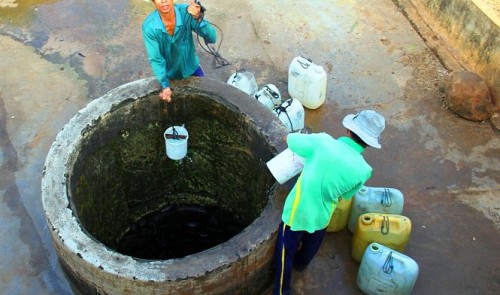Is it time for Vietnam to introduce water restrictions along the lines of other nations with similar problems?
I read in Tuoi Tre News one day a prediction that the heat wave and drought conditions across central Vietnam looked set to continue until September. Whether that becomes a reality or we get those gigantic thunderstorms with the lightning spanning the evening sky – rather awesome and another reason to visit central Vietnam – is a manner of conjecture. In other words... who knows?
Vietnam’s water resources are shrinking, particularly in the central region. Crop failures and damage to waterways are already happening. The other problem has always been to bring potable water to the majority of the population – water contamination, untreated wastewater, and poor control of groundwater resources also threaten the nation.
Other nations already strictly control their water usage. As a quick example: the authorities in southern California have already imposed water cuts due to their prolonged drought conditions for the past few years. And although Australia is now in winter and suffered huge storms during this past summer, temperatures were higher across the nation than ever.
It takes me back to distant memories of Australia, one of the driest continents on earth and the steps that nation needed to take to conserve water reserves. Australia has some of the harshest laws on water use during the summer compared to any other country. Water restrictions were introduced three decades ago for the urban areas in the south-western and eastern areas of Australia where most of our rivers flow and feed the farms and cities.
The penalties are strict. Sydney Water (the company) has imposed fines of $200 for violations of the rules for individuals, $500 for businesses, and $2,200 for water theft.
So what’s the relevance to Vietnam? I live in the central coast region where drought and infrequent rain are taking their toll on livestock and crops. For the population here the dilemma is: water for crops or power? How do you strike a balance between the two indispensable resources? Will it become a tussle with city and countryside authorities unable to agree?
At the moment, policy seems to be to hold back as much water as possible for power generation from the dozens of micro hydroelectric plants scattered in the mountains with provincial governments releasing water when drastically needed. Water restrictions in the cities might go some way towards easing the pressure on water resources. El Nino effects and climate change are also predicted to increase pressure on farmers and cities alike. So something has to change in the way water is managed.
Solutions apart from water restrictions are already under way such as switching to more drought-resistant crops, planting crops with less water requirements and protecting fresh water sources by building more reservoirs and aquifers.
The greatest solution however might be to change people’s habits. Hosing down the shop front in the middle of the day and taking water directly from the main supply for cleaning vehicles are just two bad daily routines that should change. I still don’t believe Vietnam uses modern media effectively enough to encourage attitude change. One idea I’d love to see is promoting water saving at the beginning of those community shows that people’s committees across the country put on for the local folks. Maybe act out a story of water saving and the benefits. Schools and teachers also could run lessons on the importance of water in our daily lives.
To the credit of some government agencies, I’ve noticed a lot of night-time gardening going on yet the question of whether the cities should be keeping parks and traffic gardens nice and green while priorities elsewhere are more urgent is something to consider. Like most things in a developing country, the real solutions can be provided through educating the next generation and training more farmers in conservation techniques. I know that this is going on in many areas yet significant change only comes with widespread acceptance of new ideas – and that needs a big media campaign.
Someone said to me the other day, “They’ll never to listen to you.” I don’t believe that – Vietnam’s countryside is its soul – the lotus flower, a national symbol, is a water plant and what’s a picture of Vietnam without someone wearing a nón lá (conical hat) paddling a small boat with food for sale? Water is the lifeline of this country and they will listen.

























































